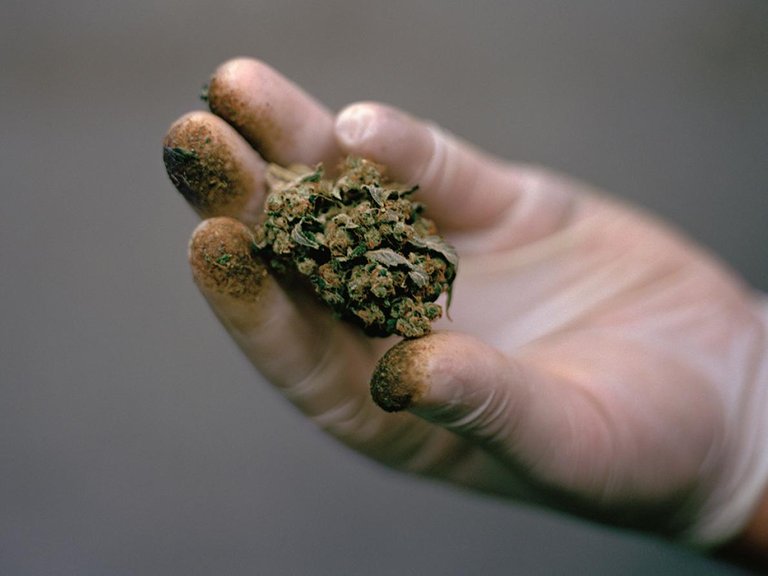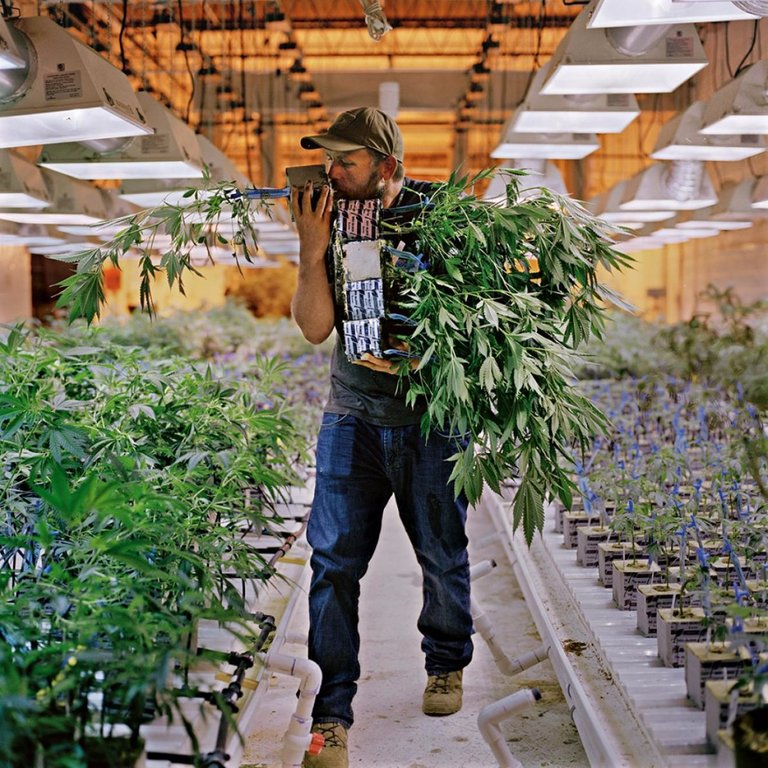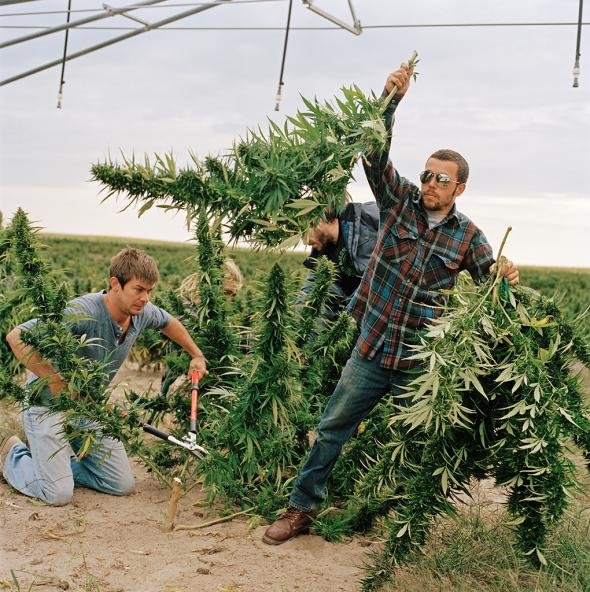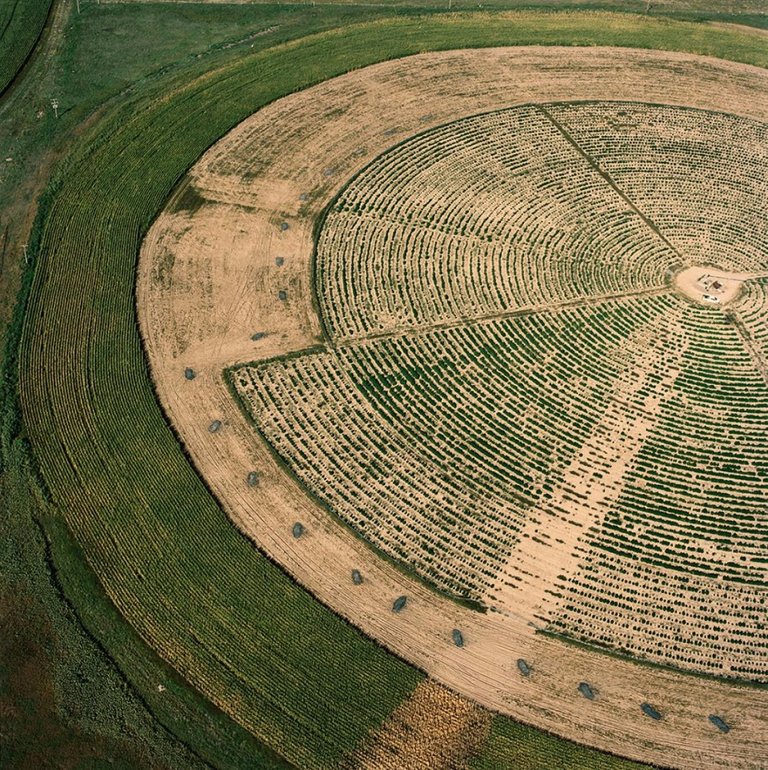As the once-vilified drug becomes more accepted, researchers around the world are trying to understand how it works and how it might fight disease.

Marijuana’s advocates believe the long-maligned plant can enhance life—and help deliver people from sickness and pain. A Seattle cannabis worker cradles the resin-dusted bud of a strain called Blueberry Cheesecake.
This story appeared in the June 2015 issue of National Geographic magazine.
There’s nothing new about cannabis, of course. It’s been around humankind pretty much forever.
In Siberia charred seeds have been found inside burial mounds dating back to 3000 B.C. The Chinese were using cannabis as a medicine thousands of years ago. Marijuana is deeply American too—as American as George Washington, who grew hemp at Mount Vernon. For most of the country’s history, cannabis was legal, commonly found in tinctures and extracts.
Then came Reefer Madness. Marijuana, the Assassin of Youth. The Killer Weed. The Gateway Drug. For nearly 70 years the plant went into hiding, and medical research largely stopped. In 1970 the federal government made it even harder to study marijuana, classifying it as a Schedule I drug—a dangerous substance with no valid medical purpose and a high potential for abuse, in the same category as heroin. In America most people expanding knowledge about cannabis were by definition criminals.
But now, as more and more people are turning to the drug to treat ailments, the science of cannabis is experiencing a rebirth. We’re finding surprises, and possibly miracles, concealed inside this once forbidden plant. Although marijuana is still classified as a Schedule I drug, Vivek Murthy, the U.S. surgeon general, recently expressed interest in what science will learn about marijuana, noting that preliminary data show that “for certain medical conditions and symptoms” it can be “helpful.”
At Noho’s Finest, a medical marijuana dispensary in the Los Angeles area, Damaris Diaz checks the scent and stickiness of her products.

In northern California, recovering meth addicts Nicholas and Richard Lopez take photographs of their harvest to share online.

Cash is the norm for many cannabis businesses, even in Colorado, because banks are reluctant to handle money from marijuana-related sales. Jayson “Giddy Up” Emo, who runs a Denver firm that makes machines for extracting chemicals from cannabis, protects his proceeds the old-fashioned way—with firepower.

In 23 states and the District of Columbia cannabis is legal for some medical uses, and a majority of Americans favor legalization for recreational use. Other countries are rethinking their relationship to pot too. Uruguay has voted to legalize it. Portugal has decriminalized it. Israel, Canada, and the Netherlands have medical marijuana programs, and in recent years numerous countries have liberalized possession laws.
Ganja is simply around us more, its unmistakable but increasingly unremarkable smell hanging in the air. Yes, smoking it may lead to temporary laughing sickness, intense shoe-gazing, amnesia about what happened two seconds ago, and a ravenous yearning for Cheez Doodles. Though there’s never been a death reported from an overdose, marijuana—especially today’s stout iterations—is also a powerful and in some circumstances harmful drug.
Still, for many, cannabis has become a tonic to dull pain, aid sleep, stimulate appetite, buffer life’s thumps and shocks. Pot’s champions say it peels back layers of stress. It’s also thought to be useful as, among other things, an analgesic, an antiemetic, a bronchodilator, and an anti-inflammatory. It’s even been found to help cure a bad case of the hiccups. Compounds in the plant, some scientists contend, may help the body regulate vital functions—such as protecting the brain against trauma, boosting the immune system, and aiding in “memory extinction” after catastrophic events.
In the apparent rush to accept weed into the mainstream, to tax and regulate it, to legitimize and commodify it, important questions arise. What’s going on inside this plant? How does marijuana really affect our bodies and our brains? What might the chemicals in it tell us about how our neurological systems function? Could those chemicals lead us to beneficial new pharmaceuticals?
If cannabis has something to tell us, what’s it saying?
The Chemist: Treasure Trove
Even into the middle of the 20th century, science still didn’t understand the first thing about marijuana. What was inside it and how it worked remained a mystery. Because of its illegality and tainted image, few serious scientists wanted to besmirch their reputations by studying it.
Then one day in 1963 a young organic chemist in Israel named Raphael Mechoulam, working at the Weizmann Institute of Science outside Tel Aviv, decided to peer into the plant’s chemical composition. It struck him as odd that even though morphine had been teased from opium in 1805 and cocaine from coca leaves in 1855, scientists had no idea what the principal psychoactive ingredient was in marijuana. “It was just a plant,” says Mechoulam, now 84. “It was a mess, a mélange of unidentified compounds.”
So Mechoulam called the Israeli national police and scored five kilos of confiscated Lebanese hashish. He and his research group isolated—and in some cases also synthesized—an array of substances, which he injected separately into rhesus monkeys. Only one had any observable effect. “Normally the rhesus monkey is quite an aggressive individual,” he says. But when injected with this compound, the monkeys became emphatically calm. “Sedated, I would say,” he recalls with a chuckle.
Orrin Devinsky, a neurologist at New York University, is more skeptical. He’s leading a clinical trial to test CBD against a placebo in treating forms of epilepsy. “There’s real potential,” he says, “but we urgently need valid data.”

Further testing found what the world now knows: This compound is the plant’s principal active ingredient, its mind-altering essence—the stuff that makes you high. Mechoulam, along with a colleague, had discovered tetrahydrocannabinol (THC). He and his team also elucidated the chemical structure of cannabidiol (CBD), another key ingredient in marijuana, one that has many potential medical uses but no psychoactive effect on humans.
For these breakthroughs and many others, Mechoulam is widely known as the patriarch of cannabis science. Born in Bulgaria, he is a decorous man with wispy white hair and watery eyes who wears natty tweeds, silk scarves, and crisp dress slacks. He’s a respected member of the Israel Academy of Sciences and Humanities and an emeritus professor at Hebrew University’s Hadassah Medical School, where he still runs a lab. The author of more than 400 scientific papers and the holder of about 25 patents, this kindly grandfather has spent a lifetime studying cannabis, which he calls a “medicinal treasure trove waiting to be discovered.” His work has spawned a subculture of cannabis research around the globe. Though he says he’s never smoked the stuff, he’s a celebrity in the pot world and receives prodigious amounts of fan mail.
“It’s all your fault,” I say to him when we meet in his book-lined, award-crammed office to discuss the explosion of interest in the science of marijuana.
“Mea culpa!” he replies with a smile.
Israel has one of the world’s most advanced medical marijuana programs. Mechoulam played an active role in setting it up, and he’s proud of the results. More than 20,000 patients have a license to use cannabis to treat such conditions as glaucoma, Crohn’s disease, inflammation, appetite loss, Tourette’s syndrome, and asthma.
Despite that, he’s not particularly in favor of legalizing cannabis for recreational use. He doesn’t think anyone should go to jail for possessing it, but he insists that marijuana is “not an innocuous substance”—especially for young people. He cites studies showing that the prolonged use of high-THC strains of marijuana can change the way the developing brain grows. He notes that in some people cannabis can provoke serious and debilitating anxiety attacks. And he points to studies that suggest cannabis may trigger the onset of schizophrenia among those who have a genetic predisposition to the disease.
If he had his way, what Mechoulam regards as the often irresponsible silliness of recreational pot culture would give way to an earnest and enthusiastic embrace of cannabis—but only as a medical substance to be strictly regulated and relentlessly researched. “Right now,” he complains, “people don’t know what they’re getting. For it to work in the medical world, it has to be quantitative. If you can’t count it, it’s not science.”
In 1992 Mechoulam’s quest for quantification led him from the plant itself to the inner recesses of the human brain. That year he and several colleagues made an extraordinary discovery. They isolated the chemical made by the human body that binds to the same receptor in the brain that THC does. Mechoulam named it anandamide—from the Sanskrit for “supreme joy.” (When asked why he didn’t give it a Hebrew name, he replies, “Because in Hebrew there are not so many words for happiness. Jews don’t like being happy.”)
Since then several other so-called endocannabinoids and their receptors have been discovered. Scientists have come to recognize that endocannabinoids interact with a specific neurological network—much the way that endorphins, serotonin, and dopamine do. Exercise, Mechoulam notes, has been shown to elevate endocannabinoid levels in the brain, and “this probably accounts for what jogging enthusiasts call runner’s high.” These compounds, he explains, apparently play an important role in such basic functions as memory, balance, movement, immune health, and neuroprotection.
Typically, pharmaceutical companies making cannabis-based medicines have sought to isolate individual compounds from the plant. But Mechoulam strongly suspects that in some cases those chemicals would work much better in concert with other compounds found in marijuana. He calls this the entourage effect, and it’s just one of the many cannabis mysteries that he says require further study.
“We have just scratched the surface,” he says, “and I greatly regret that I don’t have another lifetime to devote to this field, for we may well discover that cannabinoids are involved in some way in all human diseases.”
Phillip Hague, the chief horticulturist at a Denver cannabis company called Mindful, sniffs the roots of a plant to check on their health. He’s interested in developing new strains with higher concentrations of marijuana’s lesser known compounds that appear to have medical uses. “Cannabis speaks to me,” he says.

The Botanist: Into the Light
The 44,000-square-foot building hulks across from a police station in an industrial part of Denver, along a gritty stretch of converted warehouses that’s come to be known as the Green Mile. There’s nothing to indicate the nature of the enterprise. The door buzzes open, and I’m met by the chief horticulturist of Mindful, one of the largest cannabis companies in the world. A druidlike 38-year-old with keen blue eyes, Phillip Hague wears fatigues, hiking boots, and the incredulous grin of someone who—through a confluence of events he never imagined possible—has found his exact life’s calling.
Hague is a self-described plantsman, a dirty-thumbed gardener since he was eight and a devotee of the great agricultural scientist Luther Burbank. For years Hague grew poinsettias, caladiums, chrysanthemums, and other plants at his family’s nursery in Texas. But now his attentions are lavished on much more lucrative buds.
He leads me through Mindful’s bustling front offices and into its interior corridors. In freezers Mindful stores seeds from all over—Asia, India, North Africa, the Caribbean. A world traveler who’s become something of a Johnny Appleseed for marijuana, Hague is extremely interested in the plant’s historical biodiversity, and his seed bank of rare, wild, and ancient strains is a significant part of Mindful’s intellectual property. “We have to recognize that humans evolved with it practically since the dawn of time,” he says. “It’s older than writing. Cannabis use is part of us, and it always has been. It spread from Central Asia after the last ice age and went out across the planet with man.”
Jordan Stanley (at left) cuts down marijuana plants, and Michael Atchley collects them to stack. Jordan and his brother Jared are growing about 36,000 plants, most of them strains developed to produce high concentrations of CBD, which is sought after for its medical uses. The men believe their harvest will help the thousands of families seeking high-CBD oil.

Hague joined Colorado’s green revolution nearly at the beginning. When the U.S. Justice Department announced in 2009 that it would not focus on prosecuting people who complied with state medical marijuana laws, he looked at his wife and said, “We’re moving to Denver.” Now he runs one of the world’s most prominent “grows,” where more than 20,000 cannabis plants thrive.
We file past the curing rooms and down a hallway pulsating with pumps, fans, filters, generators, trimming machines. A forklift trundles by. Surveillance cameras capture everything, as young workers in medical scrubs scurry about, their faces lit with the pressure and promise of an unorthodox business that’s boomed beyond comprehension. Mindful has big plans to expand, building similar facilities in other states. “Pot is hot!” Hague says with a laugh that conveys amazement and exhaustion. “I’m blown away by what’s happening here every single day.”
He throws open an industrial door, and my eyeballs are scalded by a halo of plasma bulbs. We step into an immense, warm room that smells like a hundred Yes concerts. Once my eyes adjust, I can see the crop in all its rippling glory—close to a thousand female plants standing six feet tall, their roots bathed in a soup of nutrients, their spiky leaves nodding in the breeze of the oscillating fans. Here in a sweep of the eye is more than a half million dollars’ worth of artisanal pot.
I lean over to sniff one of the powdery, tightly clustered flower buds, purple-brown and coursing with white wisps. These tiny trichomes fairly ooze with cannabinoid-rich resin. This strain is called Highway Man, after a Willie Nelson song. Hybridized by Hague, it’s a variety loaded with THC. The best parts will be trimmed by hand, dried, cured, and packaged for sale at one of Mindful’s dispensaries. “This whole room will be ready for harvest in just a few days,” Hague notes with the subtle smirk of a competitive breeder who’s won international awards for his strains.
But Hague has something else he wants to show me. He leads me into a moist propagation room, where a young crop is taking root in near darkness. These babies, tagged with yellow labels, are being grown strictly for medical purposes. They’re all clones, cuttings from a mother plant. Hague is proud of this variety, which contains almost no THC but is rich in CBD and other compounds that have shown at least anecdotal promise in treating such diseases and disorders as multiple sclerosis, psoriasis, post-traumatic stress disorder, dementia, schizophrenia, osteoporosis, and amyotrophic lateral sclerosis (Lou Gehrig’s disease).
“It’s these low-THC strains that really keep me up at night, dreaming about what they can do,” Hague says, noting that marijuana contains numerous substances—cannabinoids, flavonoids, terpenes—that have never been investigated in depth.
“It sounds hokey,” he says as he caresses one of the cuttings like a gloating father, “but I believe cannabis has a consciousness. It’s tired of being persecuted. It’s ready to step out into the light.”
The Biochemist: Miracle Cure?
By now nearly everyone has heard that cannabis can play a palliative role for cancer sufferers, especially in alleviating some of the nasty side effects of chemotherapy. There’s no question that pot can stave off nausea, improve appetite, and help with pain and sleep. But could it cure cancer? Troll the Internet and you’ll see hundreds, if not thousands, of such claims. A gullible Googler could easily believe we’re on the brink of a miracle cure.
At Denver’s LivWell, which has an enormous indoor growing operation, workers remove marijuana leaves before the buds are trimmed, keeping the plants destined for medical use separate from those for recreational use. After Colorado legalized marijuana, thousands of young people from all over the world flocked to the state to participate in the multimillion-dollar business phenomenon that’s been called the Green Rush.

The majority of these claims are anecdotal at best and fraudulent at worst. But there are also mentions of laboratory evidence pointing to cannabinoids as possible anticancer agents, and many of these reports lead to a lab in Spain run by a thoughtful, circumspect man named Manuel Guzmán.
Guzmán is a biochemist who’s studied cannabis for about 20 years. I visit him in his office at the Complutense University of Madrid, in a golden, graffiti-splotched building on a tree-lined boulevard. A handsome guy in his early 50s with blue eyes and shaggy brown hair tinged with gray, he speaks rapidly in a soft voice that makes a listener lean forward. “When the headline of a newspaper screams, ‘Brain Cancer Is Beaten With Cannabis!’ it is not true,” he says. “There are many claims on the Internet, but they are very, very weak.”
He blinks thoughtfully, then turns to his computer. “However, let me show you something.” On his screen flash two MRIs of a rat’s brain. The animal has a large mass lodged in the right hemisphere, caused by human brain tumor cells Guzmán’s researchers injected. He zooms in. The mass bulges hideously. The rat, I think, is a goner. “This particular animal was treated with THC for one week,” Guzmán continues. “And this is what happened afterward.” The two images that now fill his screen are normal. The mass has not only shrunk—it’s disappeared. “As you can see, no tumor at all.”
In this study Guzmán and his colleagues, who’ve been treating cancer-riddled animals with cannabis compounds for 15 years, found that the tumors in a third of the rats were eradicated and in another third, reduced.
This is the kind of finding that gets the world excited, and Guzmán constantly worries that his breakthrough research may give cancer sufferers false hope—and fuel specious Internet claims. “The problem is,” he says, “mice are not humans. We do not know if this can be extrapolated to humans at all.”
Guzmán leads me around his cramped lab—centrifuges, microscopes, beakers, petri dishes, a postdoc researcher in a white smock extracting tissue from a mouse corpse pinned under bright lights. It’s your typical bioresearch lab, except that everything is devoted to the effects of cannabis on the body and brain. The lab focuses not just on cancer but also on neurodegenerative diseases and on how cannabinoids affect early brain development. On this last topic the Guzmán group’s research is unequivocal: Mice born of mothers regularly given high doses of THC during pregnancy show pronounced problems. They’re uncoordinated, have difficulty with social interactions, and have a low anxiety threshold—they’re often paralyzed with fear at stimuli, such as a cat puppet placed near their cage, that don’t upset other juvenile mice.
The lab also has studied how the chemicals in cannabis, as well as cannabinoids like the anandamide produced by our bodies, protect our brains against various types of insults, such as physical and emotional trauma. “Our brain needs to remember things, of course,” says Guzmán, “but it also needs to forget things—horrific things, unnecessary things. It’s much like the memory in your computer—you have to forget what is not necessary, just like you need to periodically delete old files. And you have to forget what is not good for your mental health—a war, a trauma, an aversive memory of some kind. The cannabinoid system is crucial in helping us push bad memories away.”
But it’s Guzmán’s brain tumor research that has captured headlines—and the interest of pharmaceutical companies. Through his years of research he has ascertained that a combination of THC, CBD, and temozolomide (a moderately successful conventional drug) works best in treating brain tumors in mice. A cocktail composed of these three compounds appears to attack brain cancer cells in multiple ways, preventing their spread but also triggering them, in effect, to commit suicide.
Now a groundbreaking clinical trial based on Guzmán’s work is under way at St. James’s University Hospital, in Leeds, England. Neuro-oncologists are treating patients who have aggressive brain tumors with temozolomide and Sativex, a THC-CBD oral spray developed by GW Pharmaceuticals.
Guzmán cautions against overoptimism but welcomes the beginning of human studies. “We have to be objective,” he says. “At least the mind-set is opening around the world, and funding agencies now know that cannabis, as a drug, is scientifically serious, therapeutically promising, and clinically relevant.”
Will cannabis help fight cancer? “I have a gut feeling,” he says, “that this is real.”
The Caregiver: Medical Migrants
The seizures started in May 2013 when she was six months old. Infantile spasms, they were called. It looked like a startle reflex—her arms rigid at her side, her face a frozen mask of fear, her eyes fluttering from side to side. Addelyn Patrick’s little brain raced and surged, as though an electromagnetic storm were sweeping through it. “It’s your worst possible nightmare,” her mother, Meagan, says. “Just awful, awful, awful to watch your child in pain, in fear, and there’s nothing you can do to stop it.”
From their small town in southwestern Maine, Meagan and her husband, Ken, took Addy to Boston to consult with neurologists. These epileptic seizures, they concluded, were the result of a congenital brain malformation called schizencephaly. One of the hemispheres of Addy’s brain had not developed fully in utero, leaving an abnormal cleft. She also had a related condition called optic nerve hypoplasia, which caused her eyes to wander—and which, further tests revealed, made her all but blind. By summer Addy was having 20 to 30 seizures a day. Then 100 a day. Then 300. “Everything was misfiring all at once,” says Meagan. “We were afraid we were going to lose her.”
The Patricks followed the advice they’d been given and heavily medicated Addy with anticonvulsants. The powerful meds reduced her seizures, but they also put her to sleep for almost the entire day. “Addy was gone,” Meagan says. “She just lay there, sleeping all the time. Like a rag doll.”
Meagan quit her job as a third-grade teacher to care for her daughter. Over nine months Addy was hospitalized 20 times.
Lily Rowland receives a dose of an oil derived mainly from cannabidiol (CBD), a nonpsychoactive substance in marijuana. She used to suffer hundreds of seizures with violent convulsions every day. Her family moved to Colorado, which voted to legalize marijuana in 2012, so that she could begin a daily regimen.

The drug doesn’t work for everyone, but today nine-year-old Lily is often seizure free and on her worst days has only one or two.

When Meagan’s in-laws suggested they look into medical marijuana, she recoiled. “This is a federally illegal drug we are talking about,” she recalls thinking. But she did her own research. A good deal of anecdotal evidence shows that high-CBD strains of cannabis can have a strong antiseizure effect. The medical literature, though scant, goes back surprisingly far. In 1843 a British doctor named William O’Shaughnessy published an article detailing how cannabis oil had arrested an infant’s relentless convulsions.
In September 2013 the Patricks met with Elizabeth Thiele, a pediatric neurologist at Boston’s Massachusetts General Hospital who’s helping lead a study of CBD in treating refractory childhood epilepsy. Legally, Thiele could not prescribe cannabis to Addy or even recommend it. But she strongly advised the Patricks to consider all medical options.
Encouraged, Meagan went to Colorado and met with parents whose epileptic children were taking a strain of cannabis called Charlotte’s Web, named for a little girl, Charlotte Figi, who’d responded astonishingly well to the low-THC, high-CBD oil produced near Colorado Springs.
What Meagan saw in Colorado impressed her—the growing knowledge base of cannabis producers, the kinship of parents coping with similar ordeals, the quality of the dispensaries, and the expertise of the test labs in ensuring consistent cannabis-oil formulations. Colorado Springs had become a mecca for a remarkable medical migration. More than a hundred families with children who had life-threatening medical conditions had uprooted themselves and moved. These families, many of them associated with a nonprofit organization called the Realm of Caring, consider themselves “medical refugees.” Most couldn’t medicate their children with cannabis in their home states without risking arrest for trafficking or even child abuse.
Meagan experimented with high-CBD oil. The seizures all but stopped. She weaned Addy off some of her other meds, and it was as though she’d come back from a coma. “It sounds like a small thing,” says Meagan. “But if you have a child who smiles for the first time in many, many months, well, your whole world changes.”
By early last year the Patricks had made up their minds. They would move to Colorado to join the movement. “It was a no-brainer,” Meagan says. “If they were growing something on Mars that might help Addy, I’d be in my backyard building a spaceship.”
When I meet the Patricks in late 2014, they’ve settled into their new home on the north side of Colorado Springs. Pikes Peak looms in their living room window. Addy is thriving. Since first taking CBD oil, she hasn’t been hospitalized. She still has occasional seizures—one or two a day—but they’re less intense. Her eyes wander less. She listens more. She laughs. She’s learned how to hug and has discovered the power of her vocal cords.
Critics contend that the Realm of Caring parents are using their kids as guinea pigs, that not enough studies have been done, that many, if not most, of the claims can be dismissed as the result of the placebo effect. “It’s true, we don’t know the long-term effects of CBD, and we should study it,” Meagan says. “But I can tell you this. Without it, our Addy would be a sack of potatoes.” No one asks, she notes, about the long-term effects of a widely used pharmaceutical that has been routinely prescribed for her two-year-old. “Our insurance pays for it, no questions asked,” she says. “But it’s highly addictive, highly toxic, turns you into a zombie, and can actually kill you. And yet it’s perfectly legal.”
Kim Clark’s younger son, Caden, 11, suffers from severe epilepsy. Despite having brain surgery twice, he’d never had a seizure-free day until he started taking CBD oil.

Caden’s brother, Jax, 13, had suggested that the family move to Colorado to try CBD. “There was a person in there waiting to be unlocked. I could see him but I couldn’t reach him,” Kim says. “I want everyone to come to see him—legislators, doctors, researchers.”

Thiele says early results of the CBD study are extremely encouraging. “CBD is not a silver bullet—it doesn’t work for everybody,” she cautions. “But I’m impressed. It clearly can be a very effective treatment for many people. I have several kids in the study who’ve been completely seizure free for over a year.”
Reports like these only deepen Meagan’s frustrations with what she has come to regard as the imbecility of federal marijuana laws that put her at risk of arrest for transporting a drug that “wouldn’t get a mouse high” across state lines. “It’s unacceptable,” she says, “that we’re allowing our citizens to suffer like this.”
But the Patricks are in a good place now—happier than they’ve been in years. “We have Addy back again,” Meagan says. “If I wasn’t living through this, I don’t know that I’d believe it myself. I don’t feel like cannabis is a miracle cure. But I feel like it should be a tool in every neurologist’s toolbox, all around the country.”
The Geneticist: Building the Map
“It’s such an interesting plant, such a valuable plant,” says Nolan Kane, who specializes in evolutionary biology. “It’s been around for millions of years, and it’s one of man’s oldest crops. And yet there are so many basic problems that need to be answered. Where did it come from? How and why did it evolve? Why does it make all these suites of compounds? We don’t even know how many species there are.”
We’re standing in a laboratory greenhouse on the campus of the University of Colorado Boulder looking at ten hemp plants that Kane recently procured for research purposes. They’re spindly, stalky little things, like gangling teenagers, a far cry from the lascivious crop that Hague had shown me. These plants, like nearly all hemp varieties, carry extremely low levels of THC.
They may not look threatening, but their very presence here, in the confines of a major university lab, represents years of wrangling to win federal and university approval. Right now, Kane’s allowed to grow only hemp strains. The rest of his research material is cannabis DNA, which is supplied by Colorado growers who extract it using methods he’s taught them.
Kane fingers one of his innocuous-looking plants, expressing mild bemusement at the U.S. ban on commercial hemp cultivation. “Hemp produces fibers of unparalleled quality,” he notes. “It’s a tremendously high biomass crop that replenishes the soil and doesn’t require much in terms of inputs. We import tons and tons of hemp each year from China and even Canada, yet as a matter of federal policy, we can’t legally grow it. There are places where farmers in the U.S. can literally look across the Canadian border and see fields that are yielding huge profits.”
Marijuana grows in an irrigated field on the plains east of Denver—discreetly hidden behind rows of corn. This crop is hemp, a nonpsychoactive variety with little tetrahydrocannabinol (THC). Its tough fiber has long been used for rope, paper, and fabric, but it’s also rich in compounds with medical promise. Some of this harvest will be used to make CBD oil, which is in such demand to treat children with seizures that cannabis growers have stepped up production.

A geneticist, Kane studies cannabis from a unique perspective—he probes its DNA. He’s an affable, outdoorsy guy with a bright face and eyes that wander and dart inquisitively when he talks. He has studied chocolate and for many years the sunflower, eventually mapping its genome, a sequence of more than three and a half billion nucleotides. Now he’s moved on to marijuana. Though its sequence is much shorter, roughly 800 million nucleotides, he considers it a far more intriguing plant.
A sketchy outline of the cannabis genome already exists, but it’s highly fragmented, scattered into about 60,000 pieces. Kane’s ambitious goal, which will take many years to achieve, is to assemble those fragments in the right order. “The analogy I use is, we have 60,000 pages of what promises to be an excellent book, but they’re strewn all over the floor,” he says. “We have no idea yet how those pages fit together to make a good story.”
Many people are more than a little eager to learn how Kane’s story will play out. “There’s a certain pressure,” he says, “because this work will have huge implications, and anything we do in this lab will be under a lot of scrutiny. You can feel it. People are just wanting this to happen.”
Once the map is complete, enterprising geneticists will be able to use it in myriad ways, such as breeding strains that contain much higher levels of one of the plant’s rare compounds with medically important properties. “It’s like discovering some hidden motif deep in a piece of music,” Kane says. “Through remixing, you can accentuate it and turn it up so that it becomes a prominent feature of the song.”
As Kane leads me around his lab, I see the excitement on his face and on the faces of his young staff. The place feels almost like a start-up company. “So much of science is incremental,” he says, “but with this cannabis work, the science will not be incremental. It will be transformative. Transformative not just in our understanding of the plant but also of ourselves—our brains, our neurology, our psychology. Transformative in terms of the biochemistry of its compounds. Transformative in terms of its impact across several different industries, including medicine, agriculture, and biofuels. It may even transform part of our diet—hemp seed is known to be a ready source of a very healthy, protein-rich oil.”
Cannabis, Kane says, “is an embarrassment of riches.”
By Hampton Sides
Photographs by Lynn Johnson
By The time you finish reading this it'll be around 4:20 here!... Happy toking everyone!.